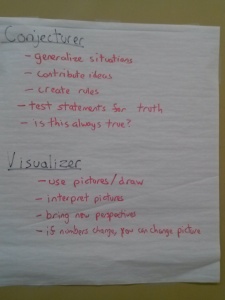When we learned about planning back in grad school, we were told that if something is important, you need to assess it; if you don’t assess it, then it’s not important. When the Common Core Standards came out, most math teachers were very excited about the Standards of Practice. The problem was, of course, that the Standards of Practice are hard to assess. So most standardized tests that use the Common Core don’t assess them, which of course means they don’t get implemented in the same way as the content standards. The Standards of Practice are important to me (though I frame them as the Mathematical Habits of Mind), and that means I need to find a way to assess them. But I’ve never had a really good way to test them before – I was always kind of making it up as I went along. Now, though, I think I’ve hit on something now that really works.
After seeing Ashli’s video about not putting grades on papers, I stopped doing it this year – but having the grades still be there in the online gradebook wasn’t quite what I wanted to do, and it became very hard to keep track things, especially because classwork and homework were what I used to measure the Standards of Practice. This semester I gave written feedback on all the assignments that I’ve given but recorded no grades – not even in my own gradebook – the only thing I kept track of was if something was incomplete or missing.
If we decide that every assignment is a formative assessment, we can’t possibly grade it as students are learning the material. So instead each assignment is like a first draft (or second or third) and students can read the feedback that I gave and make changes in order to improve their work. Come the end of the marking period (or eventually the end of the semester) students create a portfolio of their work. They don’t need to include everything that they’ve done but rather a representative sample that shows that they apply the Standards of Practice/Habits of Mind as they work.
The portfolio has a cover sheet (shown below) that that asks them to reflect on what habits they have used in their mathematical work this semester.
They have to find evidence of their own habits in their work and write a few sentences citing that evidence. I gave suggestions of which assignments might be easier to find evidence of those habits in. And they only had to include work that they cited as evidence as part of the portfolio.
To get us started we read through the rubrics that I created for the habits and created posters of what those habits might look like when doing assignments. We have them hanging on the walls of my classroom – that way I can referr to them easily when something comes up (such as when we worked on Des-man, I tried to emphasize the tinkering nature of the process).
The first portfolios coming in have been graded and some of them were stellar and others need some work, but it was the first time and they are not really used to this whole reflective idea. But I have noticed that most of my students have started to use that vocabulary more and have become more aware of the kind of things that they are expected of them in the long-term, not just immediate math facts. I think if I start this from the beginning next year it’ll create a really great culture of thinking using the habits and the standards of practice.




Comments on: "SoP Portfolios" (5)
[…] my portfolio idea was working out well, but I was getting overwhelmed with the written feedback. It took so long […]
[…] previous portfolios in my class, students have asked me how I want them to format their work. Should they write their […]
[…] fifth year, I introduced the Standards of Practice portfolios as a way to grade on those standards and, thus, have them be valued in my class. To go along with […]
[…] that they turn in to show evidence of different traits. And this came up again in that session. James Cleveland has done it. Tina Cardone has done it. I want to do it. But aaaah! The time to make it into a reality! Argh! […]
[…] first wrote about my portfolios in this post, and the general idea there still applies to my Doing Mathematics portfolio, but the structure is […]